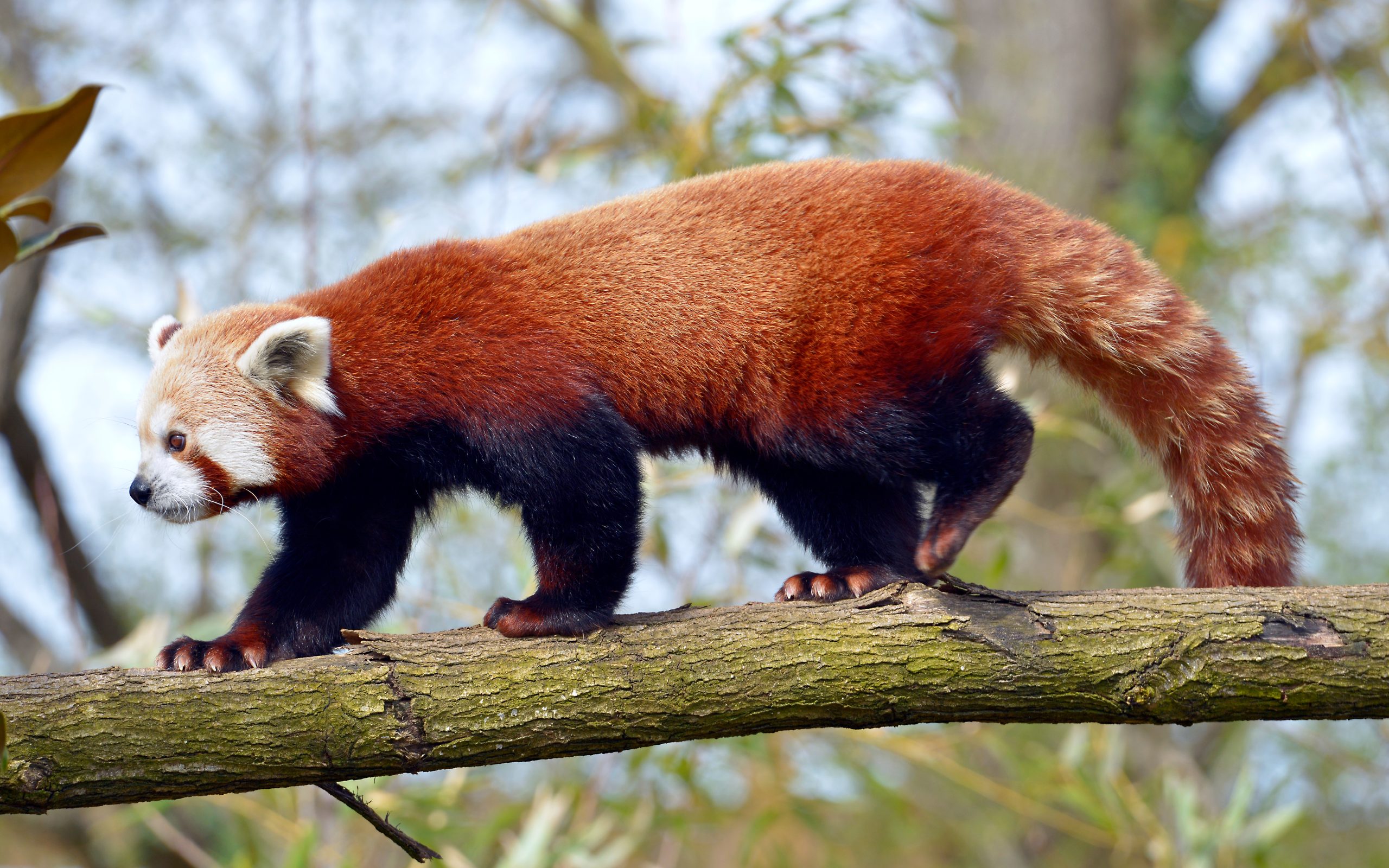The Enigmatic World of Red Pandas: Top 10 Fascinating Facts

Welcome to the mystical realm of red pandas, a species shrouded in both allure and mystery. Nestled within the dense forests of the Eastern Himalayas and Southwest China, these elusive mammals captivate the hearts of many with their adorable features and unique behaviors.
Unlike their namesake, the giant panda, red pandas are smaller, tree-dwelling creatures that boast a fiery-red fur coat, a mischievous expression, and a bushy, ringed tail. Their habitat—a verdant expanse high in the mountains—provides not just a backdrop for their fascinating lives but also plays a pivotal role in the ecological balance of their environment.
In this blog post, we will explore the top 10 fascinating facts about red pandas, from their intriguing dietary habits to their critical conservation status.
Join us as we unravel the mysteries of these enchanting animals and discover why the red panda’s fight for survival is intricately linked to the well-being of our planet.
1. The Himalayan Hometown
Nestled within the serene landscapes of the Eastern Himalayas, the natural habitat of the red panda is as captivating as the creature itself. This mountainous region provides a lush, verdant sanctuary that is critical for the survival of these enigmatic mammals.
Flanked by dense forests and rich in bamboo, the red panda’s environment is a complex ecosystem that supports not just these creatures but a myriad of other species.
At elevations ranging from 2,200 to 4,800 meters, the cool temperate forests offer the seclusion and rich foliage that red pandas thrive in. These altitudinal zones ensure an ample supply of their primary food source—bamboo.
However, it’s not just their dietary needs that are met here; the thick canopy and understory provide essential shelter and camouflage from predators.
The Himalayas, with their rugged terrain and varying climate, shape the very existence of the red panda, influencing their behavioral patterns, breeding cycles, and migration habits.
This region, thus, is not just a ‘hometown’ but a cradle of life that sustains the delicate balance required for these creatures to thrive.
2. More Than Just a “Panda”
Despite the shared name, red pandas and giant pandas part ways when it comes to their genetic tapestry, highlighting an intriguing aspect of nature’s complexity.
Diverging significantly in their taxonomy, red pandas are not merely miniature versions of their black-and-white counterparts but belong to the family Ailuridae, distinct from the bear family Ursidae to which giant pandas belong.
This differentiation stems from a unique evolutionary path that traces back millions of years, suggesting a lineage that is as distinctive as the creatures themselves.
The red panda, with its reddish-brown fur and raccoon-like features, is the sole member of its genus Ailurus, embodying a singular blend of traits that defy easy categorization among the animal kingdom’s well-established orders.
This revelation not only enriches our understanding of biodiversity but also challenges our perceptions, inviting us to look beyond names and appearances to appreciate the intricate web of life that connects every living being.
3. A Diet of Bamboo
Centered at the heart of the red panda’s diet is bamboo, a resilient plant that flourishes within their Himalayan habitat. Much like their distant relatives, the giant pandas, red pandas are predominantly bamboo eaters, relying on this fibrous plant for the bulk of their nutritional needs.
Despite their carnivorous classification, red pandas’ diet consists of over 95% bamboo, from which they extract minimal protein but significant fiber. Their sharp, strong teeth and the robust pseudo-thumb, a modified wrist bone, aid in grasping and stripping bamboo stalks with remarkable dexterity.
However, their diet is not solely limited to bamboo. These forest dwellers also partake in a variety of occasional treats that diversify their intake, including fruits, nuts, roots, and eggs.
Such variety not only augments their nutrition but also underscores the adaptability and omnivorous nature of red pandas, as they forage for sustenance within the confines of their mountainous homes.
4. Solitary Creatures
Solitary by nature, red pandas epitomize the quintessence of independent living within the animal kingdom. These creatures spend the majority of their life roaming alone, a testament to their solitary nature and preference for solitude over companionship.
Their territorial behavior further underscores this preference, with individuals marking their dominion with secretions from scent glands and scratches on trees. This territoriality is not only a means of asserting control but also a mechanism for avoiding conflict, ensuring that their paths seldom cross with others of their kind except during mating season.
The vast, dense forests they inhabit allow for this solitary lifestyle, offering ample space for each red panda to establish its territory.
This preference for a solitary existence is so ingrained that even when they venture down from the trees, they tread lightly on the forest floor, always wary, always alone, maintaining the delicate balance of their solitary world.
5. The Art of Camouflage
The art of camouflage is masterfully exemplified by the red panda’s unique fur color, a vivid testament to nature’s ingenuity in survival tactics.
The striking reddish-brown coat of the red panda not only sets it apart in the animal kingdom but also serves a critical function in blending seamlessly with the fiery copper of the Eastern Himalayan autumn.
This natural disguise is perfectly suited to their forest habitat, where the interplay of light and shadow amongst the trees demands a particular spectrum of color for effective concealment.
The underbelly’s softer hues, contrasting with the darker limbs and back, create an illusion of depth and texture that mimics the forest floor, while the bushy, ringed tail adds to the dappled light effect under the canopy.
This evolutionary adaptation to their surroundings enables red pandas to evade predators and approach prey with an element of surprise, showcasing the profound connection between an organism and its environment through the lens of color and survival.
6. Night Owls of the Forest
Amidst the tranquillity of the forest under the cloak of nightfall, the red panda embarks on its nocturnal escapades, transforming from a solitary figure resting in the arboreal realms to an active forager on the forest floor.
Unlike the diurnal rhythm that governs much of the animal kingdom, red pandas are crepuscular and nocturnal creatures, finding solace and security in the darkness. This time of day not only shields them from potential threats but also coincides with a drop in human activity, offering a serene environment for their foraging pursuits.
The moonlit hours are spent in search of bamboo shoots and leaves, their primary diet, using their acute senses to navigate through the dense underbrush.
However, their nocturnal activities extend beyond mere survival; it’s a time for mating calls that pierce the silent night, for grooming rituals that ensure their fur remains insulating and camouflaged, and for exploration of their territories to reinforce boundaries.
In the serenity of the night, the red panda exhibits a vibrant lifestyle that contradicts its daytime demeanor of lethargy and solitude, showcasing the complex dichotomy of its existence and survival strategies in the Himalayan forests.
7. Climbing Experts
Within the shadowed canopies of the Himalayan forests, red pandas showcase an incredible mastery of their arboreal domain, demonstrating climbing skills that are not just remarkable but vital for their survival.
These dexterous climbers use their strong, curved claws and powerful limbs to ascend the towering trees, where they find refuge, food, and solitude. Climbing for the red panda is as much a part of its lifestyle as eating bamboo or being nocturnal.
The trees offer a safe haven from predators and a vantage point for monitoring their territory. They adeptly maneuver through the branches, their agility allowing them to access the most tender and nutritious bamboo leaves and shoots that are often out of reach from the forest floor.
This crucial skill not only aids in their quest for food but also in escaping threats, underscoring the intertwined relationship between their remarkable climbing ability and their strategies for survival.
The red panda’s affinity for the heights of their mountainous habitat encapsulates the essence of adaption, painting a vivid picture of life in the high forests and the extraordinary ways in which species evolve to thrive in their environment.
8. Reproduction and Lifespan
The lifecycle of the red panda is both fascinating and intricate, encompassing unique mating rituals and a remarkably defined lifespan.
These elusive creatures engage in mating practices that are as solitary and discreet as their overall behaviour, with the mating season occurring once a year in the early spring. The communication during this period involves a series of subtle calls and scents, allowing males and females to find one another despite their typically reclusive nature.
Following a gestation period of approximately 130 days, females give birth to one to four offspring in the shelter of a hollow tree or rock crevice, providing a safe haven from predators.
The cubs are born blind and completely dependent, marking the beginning of an intensive mothering phase that lasts for the first few months of their lives. Red pandas reach sexual maturity at around 18 months of age, allowing them to continue the cycle of life.
Despite facing threats from habitat loss and predation, wild red pandas have a lifespan of up to 10 years, although individuals in captivity can live up to 15 years, thanks to comprehensive care and absence of natural predators.
This lifecycle, from the intricate mating practices to their specific lifespan, highlights the delicate balance these creatures maintain in their natural habitat and underscores the importance of conservation efforts to ensure their survival.
9. Conservation Status
The conservation status of the red panda paints a vivid image of the urgent measures needed to protect these unique creatures from the brink of extinction. Classified as “Endangered” by the International Union for Conservation of Nature (IUCN), red pandas face an uphill battle for survival, primarily due to habitat loss, deforestation, and poaching.
These threats have led to a significant decline in their population, confining them to fragmented and isolated regions within their natural habitat.
Efforts to safeguard their future are being spearheaded by numerous conservation initiatives and legal protections, aiming to curb habitat destruction and illegal hunting practices. Protected areas and wildlife sanctuaries are being established within their native regions to preserve the natural ecosystem of the red pandas.
Furthermore, breeding programs in captivity are contributing to the effort, with the dual aim of increasing population numbers and promoting awareness of their plight.
Conservationists and researchers are tirelessly working to understand the complex needs of red pandas better, advocating for policies that protect their habitats and ensure their survival for generations to come.
The collaborative focus on education, local community engagement, and international cooperation marks a hopeful path forward in the conservation of red pandas, showcasing the importance of concerted actions in the battle against extinction.
10. Cultural Significance
The cultural significance of red pandas extends far beyond their environmental role, threading itself into the fabric of local cultures and myths of the regions they inhabit. In certain Himalayan communities, red pandas are considered symbols of good luck and guardians of the forest, embodying the spirit of the mountains they roam.
Local folklore often features these elusive mammals in stories that illustrate moral lessons or explain natural phenomena, casting them as wise and benevolent characters. These narratives highlight the intertwined relationship between humans and nature, reminding communities of the importance of living in harmony with the environment.
Additionally, the red panda’s distinctive appearance has made it an icon of local art and craftsmanship, inspiring motifs in textiles, ceramics, and rituals.
By exploring the role of red pandas within these cultural contexts, we gain a deeper appreciation for the ways in which wildlife influences human culture and beliefs, underscoring the importance of preserving these animals not only for ecological balance but also for cultural heritage.
Conclusion
In unraveling the enigmatic world of red pandas, we have ventured through a rich tapestry that illustrates not only their unique adaptations and lifestyle but also the critical challenges they face towards survival.
The top 10 fascinating facts about red pandas not only shed light on their distinct characteristics and behaviors but also serve as a poignant reminder of our shared responsibility to protect these mesmerizing creatures and their habitats.
Understanding red pandas goes beyond mere appreciation of their adorable appearance; it’s about recognizing their role in the biodiversity of their ecosystems and the broader implications of their endangerment.
Conserving red pandas is an essential step towards ensuring the health and vitality of the forests they inhabit, which in turn supports a myriad of other species including our own.
By safeguarding these forests and combating the threats of habitat destruction and poaching, we contribute to a healthier, more diverse planet for future generations.
It’s a poignant reminder that in preserving the enigmatic world of red pandas, we are not only championing the cause of a single species but are also upholding the richness of life on Earth itself.
As we conclude our exploration into “The Enigmatic World of Red Pandas: Top 10 Fascinating Facts,” it becomes clear that the story of these charming creatures is far from just an account of curiosity and wonder.
It’s a rallying cry for action, an urgent call to each of us to play a role in safeguarding their future. By furthering our understanding and contributing to red panda conservation efforts, we not only aid in ensuring their survival but also in preserving the rich biodiversity of our planet.
I encourage you, dear readers, to continue learning about these captivating animals and the challenges they face. Support conservation organizations that are working tirelessly on the ground to protect red panda habitats and combat poaching.
Consider adopting a red panda through a wildlife fund, contributing to research and conservation initiatives, or simply spreading the word about their plight through your social networks. Every action, no matter how small, propels us closer to a future where red pandas thrive in the wild, their enigmatic presence a testament to the success of our collective efforts.
For more information on how you can get involved and support red panda conservation, please visit [insert relevant conservation organization website here]. Together, we can ensure that the enchanting world of red pandas continues to flourish, inspiring awe and wonder for generations to come.




